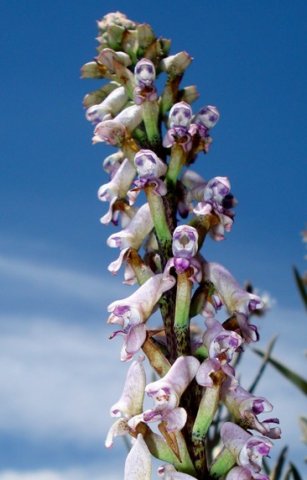Disa aconitoides subsp. aconitoides

Author: Ivan Lätti
Photographer: Judd Kirkel Welwitch
Disa aconitoides subsp. aconitoides is a slender terrestrial orchid that grows leaves and flowers annually from perennial tubers, reaching heights from 25 cm to 60 cm.
The photo shows the inflorescence at an angle from below, the flowers stuck upon their long ovaries, each ovary covered by a pale bract. This view allows the observer to look the multitude properly in the face(s). Blackish speckling on the flower stalk spreads slightly upwards onto the bases of the bracts in picture.
The species distribution is widespread in the east of South Africa, from the eastern extreme of the Western Cape coast, through the Eastern Cape to KwaZulu-Natal, Gauteng, Mpumalanga and Limpopo, as well as further in Africa to Ethiopia. Two tropical African subspecies exist, different from the one of the Cape Floristic Region and the rest of South Africa. The local one, D. aconitoides subsp. aconitoides, also spreads into tropical Africa.
The habitat of D. aconitoides subsp. aconitoides is grassland on stony slopes from the coast to altitudes around 2000 m. In the tropics it also grows in woodland. In the Tsitsikamma the plants are found in frequently mowed roadside verges, a good place for some terrestrial orchids to multiply. The habitat population is considered of least concern early in the twenty first century.
The large Disa genus, comprising about 180 species (all endemic to African and Yemen), has been divided into 18 sections, based on similarities to facilitate understanding of their development and identification. One of these sections, consisting of eight, largely tropical region species, is called Disa section Aconitoideae, named for this species. All of the members of this section have large spurs pointing up.
This Disa produces most flowers after fire, but is not dependent upon fire for flowering (Liltved and Johnson, 2012; Pooley, 1998; iNaturalist; iSpot; www.gardenology.org; http://redlist.sanbi.org).

